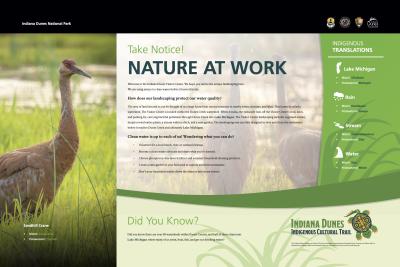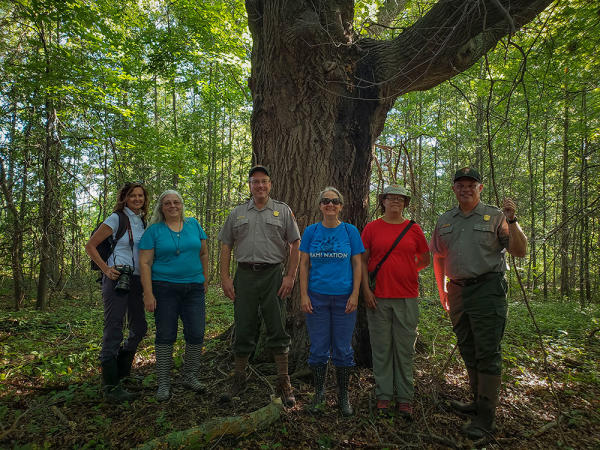|
“We’re more than just a pretty place. We’re 9,000 years of Indigenous culture. A home away from home for centuries of European immigrants. An emblem of pioneering spirit and a seat of industrial innovation … You may not know this version of the Indiana Dunes, but you will soon.” |
- Indiana Dunes Tourism home page
Visitors to the Indiana Dunes Visitor Center will soon be invited to walk along the Indiana Dunes Indigenous Cultural Trail that honors the fact that the Indiana Dunes is within the traditional lands of the Potawatomi and Miami Indigenous peoples. More than just a hiking trail, the interactive experience will weave Indigenous cultures with the natural ecology of the Indiana Dunes, one of the most biodiverse areas of the country.
For destination marketing organizations (DMOs), the years-in-the-making project will offer a great example of how to work with federal and Indigenous representatives. The Miami Tribe of Oklahoma, the Pokagon Band of Potawatomi, Indiana Dunes Tourism, and the Indiana Dunes National Park have joined together to reenvision the land around the Indiana Dunes Visitor Center.


Indiana Dunes Indigenous Cultural Trail signs with translations
Built right into the homepage of the DMO’s website, the cultural trail landing page encourages travelers to “honor with gratitude the land itself and the Indigenous Peoples who inhabited it throughout the generations.” The interactive experience will prompt visitors and locals to learn, play, touch, and ponder as they weave their way through the numerous trails. It will be more than just a hiking trail!
We asked Christine Livingston, vice president for Indiana Dunes Tourism, some questions about the project.

Christine Livingston
Vice President, Indiana Dunes Tourism
 What has been the overarching goal that’s driving this multi-year heritage project? What will this add to the destination?
What has been the overarching goal that’s driving this multi-year heritage project? What will this add to the destination?
Indiana Dunes Tourism works closely with the Indiana Dunes State and National Parks as well as local museums. We explored several trail themes and other options for the land on which the Indiana Dunes Indigenous Cultural Traill will be constructed.
During these conversations, we all came to realize that the Indigenous story is undertold in our area. Adding this important voice in the form of an interactive, educational trail with artistic components at the Indiana Dunes Visitor Center will allow us to reach tens of thousands of people in a compelling way. It is a perfect location for this trail. Our vision is to share authentic Indigenous languages and perspectives as they relate to the Indiana Dunes with the 150,000+ people who begin their Dunes adventure here each year.

Digital mock-up of the Indiana Dunes Indigenous Cultural Trail firepit
 A key element is an early and ongoing collaboration with Miami and Potawatomi tribal members. How has that collaboration happened?
A key element is an early and ongoing collaboration with Miami and Potawatomi tribal members. How has that collaboration happened?
The National Park staff has a comprehensive list of tribes from our region. They reached out initially to all the tribes who have a connection to the Indiana Dunes. The two tribes who had the time and interest in working as a part of our development team are the Pokagon Band of Potawatomi and the Miami Tribe of Oklahoma. We have been working together now for nearly five years. The team has learned and gained much from working together. Indigenous guidance and perspective have guided every aspect of trail development from the moment we brainstormed the initial concept.
 A two-part question — what has the community response been to the trail? And, how well known is (or was) the history of the Miami and Potawatomi tribes among community members?
A two-part question — what has the community response been to the trail? And, how well known is (or was) the history of the Miami and Potawatomi tribes among community members?
We have only installed the very beginnings of the trail to date. We have engineering and detailed plans but are only now beginning construction of physical trail components. Although themed signs with translations are in place and murals have been painted, the trail itself is not complete. It's a big vision, and we have a lot yet to do. But even in this beginning phase, people who learn about the trail are excited and supportive.
The response has been overwhelmingly positive in our communities, and people are looking forward to seeing the trail come into being. There is some awareness of the Potawatomi Tribe in our region. Their trails eventually became roads and are still so named. Some historic buildings also remain, and the park has some Indigenous programming. But the Miami Tribe of Oklahoma is not as well known here. This trail will fill the gaps and elevate the Indigenous voice in the Indiana Dunes. It's a missing part of the picture and our history.
 "This is more than a trail,” you have said. “It's an acknowledgment, a meaningful sharing, and a deepening of important connections between all of us and this place.” What has this project meant to you personally?
"This is more than a trail,” you have said. “It's an acknowledgment, a meaningful sharing, and a deepening of important connections between all of us and this place.” What has this project meant to you personally?
As a facilitator, my role and approach have evolved over the years. What started as an interesting project with a set of deliverables has grown into a process and collaboration I'm personally committed to.

Some of the team members in the field working to identify the route that will become the Indiana Dunes Indigenous Cultural Trail
One of the most compelling things to me about the Indiana Dunes Indigenous Cultural Trail has been the ripple effect I've observed. The trail is a conversation starter. It opens people's minds to a different perspective. I have seen time and again how this partnership goes beyond the small team working on it. As more people learn about what we are doing and why we are doing it, they broaden their perspectives, gain deeper understanding, and have a new appreciation of Indigenous perspectives.
 What advice do you have for other destinations looking for ways to deepen their collective understanding of their sometimes painful history?
What advice do you have for other destinations looking for ways to deepen their collective understanding of their sometimes painful history?
Challenging experiences are learning experiences. If we don't frame our painful past as opportunities to learn and do better, we miss the point. By seeking a deeper understanding of these events, we gain knowledge and wisdom. Judgments made out of ignorance fade, and we can truly see and appreciate each other and our individual uniqueness.
~~
For more information about the cultural trail, Indiana Dunes cultural trail works to fill knowledge gap includes the project scope, interviews, and some history of the area.
Photos courtesy of Indiana Dunes Tourism


